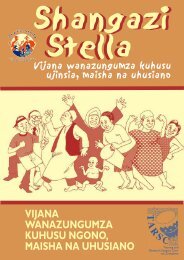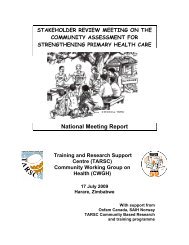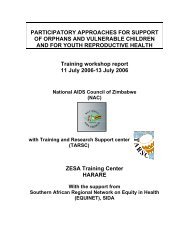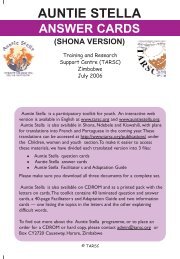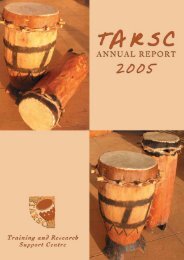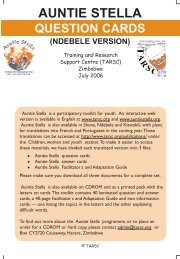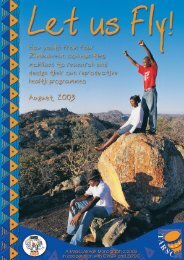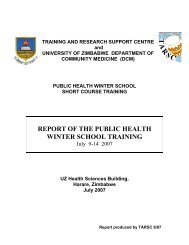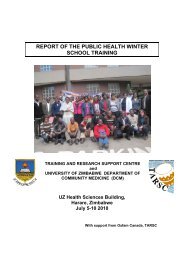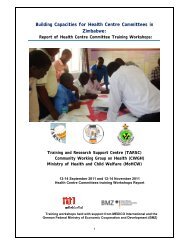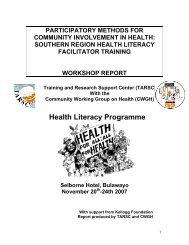BEAM rep final.pdf - Training and Research Support Centre
BEAM rep final.pdf - Training and Research Support Centre
BEAM rep final.pdf - Training and Research Support Centre
You also want an ePaper? Increase the reach of your titles
YUMPU automatically turns print PDFs into web optimized ePapers that Google loves.
disbursed/accessed in 2011; the period <strong>and</strong> time taken at each level before funds reach the<br />
district; perceived level of responsiveness <strong>and</strong> transparency by national <strong>and</strong> provincial level<br />
structures on allocations; district team <strong>and</strong> community members’ level of access to documents<br />
<strong>and</strong> resources relating to the funds, any documents made publicly available by the national<br />
level for the district <strong>and</strong> the district for the community on amount allocated <strong>and</strong> expended,<br />
when <strong>and</strong> how the information is communicated; district level perceptions on budget<br />
implementation <strong>and</strong> service delivery in relation to district <strong>and</strong> national targets.<br />
The small pilot exercise showed that there were systems in place to monitor government funds.<br />
There are various legislative <strong>and</strong> policy documents that clearly spell what is involved, who<br />
should be involved <strong>and</strong> what should be done by each part. There is also a clear process that<br />
identifies the key stakeholders in the process <strong>and</strong> how they should interact with one another.<br />
There was a challenge in accessing the relevant <strong>BEAM</strong> documents at the local level where the<br />
implementation of the funds is supposed to take place. Given the frequent staff turnover at the<br />
schools, it means that institutional memory with regards to these funds may be lost. The<br />
exercise also showed that council schools have m<strong>and</strong>atory audits unlike their government<br />
counter parts.<br />
The pilot provided important information for the logistics <strong>and</strong> tools for the full survey.<br />
2. Aims of the Assessment<br />
This larger survey explored the implementation of <strong>BEAM</strong> in terms of its beneficiaries, fund<br />
management, administration, ad resource flows.. The findings intend to inform dialogue on<br />
strengthening the implementation, accountability <strong>and</strong> oversight of the <strong>BEAM</strong>.<br />
The specific objectives of the assessment were to;<br />
assess the budget process, how they are devised, who participates at the district level;<br />
assess the selection process of <strong>BEAM</strong> beneficiaries at both the primary level <strong>and</strong><br />
secondary levels;<br />
assess the disbursement processes, expenditure processes <strong>and</strong> the monitoring<br />
processes;<br />
assess availability <strong>and</strong> quality of the budget information <strong>and</strong> the challenges in accessing<br />
<strong>and</strong> implementing <strong>BEAM</strong>;<br />
assess the level of district <strong>and</strong> community level access to key information or documents<br />
on <strong>BEAM</strong>, relating to these specific funds in particular <strong>and</strong> generally to other budget<br />
information;<br />
an analysis of district level perceptions on <strong>BEAM</strong> implementation <strong>and</strong> service delivery in<br />
relation expectations from stakeholders.<br />
3. Methods<br />
The basic design was a cross sectional survey. It was implemented within 10 districts in nine<br />
provinces of Zimbabwe.<br />
The provinces were selected as areas with highest, average <strong>and</strong> lowest need using the 2009<br />
MIMS statistics (Shown earlier in Table 1) to ensure that provinces within each need category<br />
were included in the assessment. Within each province, districts were selected using the<br />
following criteria;<br />
to include three urban <strong>and</strong> seven rural districts based on the higher share of rural<br />
residents compared to urban households<br />
12



